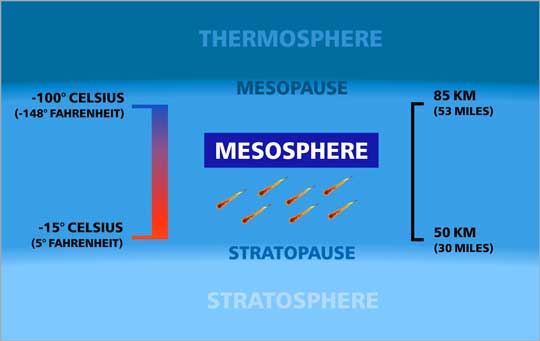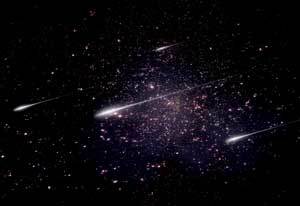Facts About The Mesosphere – What It Is And Its Defining Characteristics

Earth's atmosphere consists of five layers, each with its own features. The mesosphere is the third layer, located above the stratosphere and below the thermosphere. We explore this layer and its characteristics.
The mesosphere is one of the five layers of the atmosphere, situated above the stratosphere and below the thermosphere at an altitude of 50 km or 30 miles, extending to 85 km or 53 miles. It is the coldest of the Earth's atmospheric layers and the region where meteoroids and space debris burn up.
Although our atmosphere looks like one continuous piece of sky, it is made up out of five distinctly different layers: The troposphere, stratosphere, mesosphere, thermosphere, and exosphere. In this post, we focus on the mesosphere, Earth's third most outer layer.
This article not only examines what the mesosphere is but also looks at the characteristics or facts that define it.
Mesosphere Definition

The mesosphere is situated just above the stratosphere, with a thin layer of air called the stratopause separating the two layers.
Like the other atmospheric layers, it does not have a fixed height but starts at an altitude of approximately 50 km (30 miles), extending up to a height of roughly 85 km (53 miles).
It is also the coldest of the five layers with its upper boundary, called the mesosphere, reaching temperatures as low as -90° Celsius (-130° Fahrenheit). This region is the coldest part of the planet's atmosphere.
Temperatures drop as altitude increases in this space, unlike the stratosphere, which is characterized by a temperature inversion (a rise in temperature as altitude increases.)
"Mesosphere" is derived from the Greek word mesos sphaira, meaning "middle sphere." It is a very apt description since the mesosphere is situated in the middle of the five layers (with the troposphere and stratosphere below, and thermosphere and exosphere above it.)
Scientists know very little about this layer since it lies at a height above the upper limits of conventional aircraft but below the region where low-orbiting satellites can operate. One of the only ways to study this part of the atmosphere is by using sounding rockets.
(You can learn more about sounding/weather rockets in this article.)

What we do know, however, is that it is within this layer that the vast majority of meteoroids and space debris burn up. As a result, the mesosphere contains a fairly high amount of iron and other metallic particles.
Another feature of the mesosphere is the presence of atmospheric tides and planetary waves. These waves start in the troposphere and eventually spreads into the mesosphere.
(In the mesosphere, the waves/tides become unstable and dissipate, creating momentum in the process. It is this momentum that drives global circulation to a great extent.)
Although almost all weather-related activity is limited to the troposphere, a rare weather phenomenon called noctilucent clouds can be found in this layer at a height of approximately 80 km (50 miles.)
Facts About The Mesosphere
The following list highlights the characteristics and facts of the mesosphere in more detail.
- 1The mesosphere is the third layer of the atmosphere (above the troposphere and stratosphere.)
- 2It extends from a height of approximately 65 km (40 miles) to 85 km (53 miles) above the Earth's surface.
- 3It borders the stratosphere below through a thin transitional space called the stratopause.
- 4It borders the thermosphere above through a thin transitional space called the mesopause.
- 5It is characterized by a drop in temperature as altitude increases.
- 6It is the coldest of the five atmospheric layers, with temperatures dropping to -90° Celsius (-130° Fahrenheit) in the mesopause.
- 7Meteoroids and other small space debris burn up in this layer.
- 8A sodium layer 5 kilometers (3.1 miles) thick can be found in the upper regions of the mesosphere.
- 9Electrical discharges, called lightning sprites (also know as ELVES or red sprites), are visual phenomena that occur in the mesosphere.
- 10A rare visual phenomenon called noctilucent clouds occurs at a height of approximately 80 kilometers (50 miles) in the upper mesosphere.
- 11Although not as effective as the stratosphere, a significant amount of solar radiation is also absorbed in this layer.
- 12Combined with the stratosphere, it is often referred to as the Middle Atmosphere.
- 13It is the least known of all layers due to its limited accessibility.
This list does not contain all the data available about the mesosphere but highlights the key facts and characteristics of this layer.
Conclusion
Although it may be the least-known layer in the atmosphere, as this article illustrated, a fair amount of valuable information has already been obtained to help better understand the mesosphere and its importance much better.
The third and coldest layer of the atmosphere has just an important part to play as any of the other four atmospheric layers. This article highlighted the importance of the mesosphere, as well as examining its defining characteristics.
If you are interested in the complete structure and make-up of the atmosphere, this article covers all five atmospheric layers and their relation to each other in more detail.
Never miss out again when another interesting and helpful article is released and stay updated, while also receiving helpful tips & information by simply following this link .
Until next time, keep your eye on the weather!

